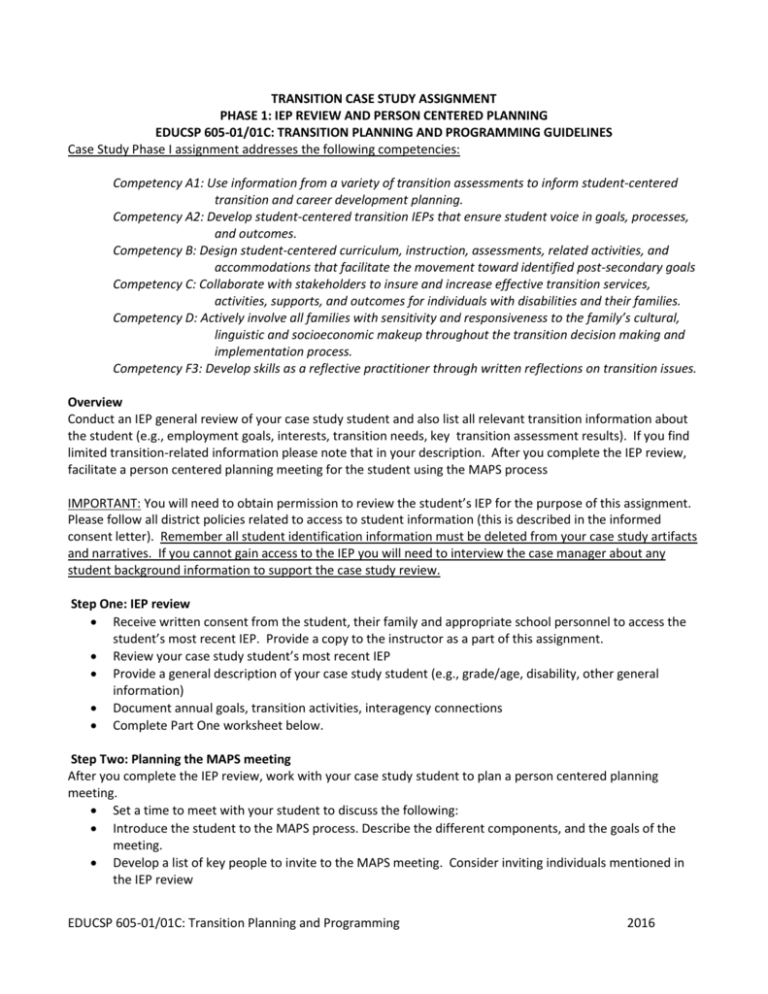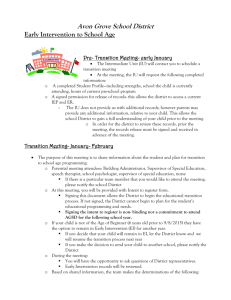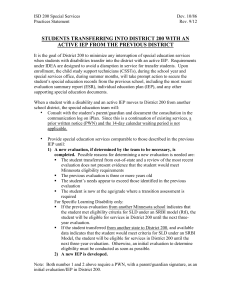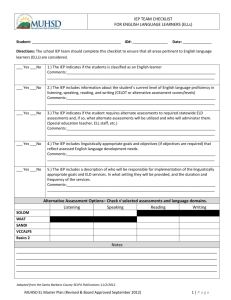Phase 1 IEP review and PCP Spring 2016
advertisement

TRANSITION CASE STUDY ASSIGNMENT PHASE 1: IEP REVIEW AND PERSON CENTERED PLANNING EDUCSP 605-01/01C: TRANSITION PLANNING AND PROGRAMMING GUIDELINES Case Study Phase I assignment addresses the following competencies: Competency A1: Use information from a variety of transition assessments to inform student-centered transition and career development planning. Competency A2: Develop student-centered transition IEPs that ensure student voice in goals, processes, and outcomes. Competency B: Design student-centered curriculum, instruction, assessments, related activities, and accommodations that facilitate the movement toward identified post-secondary goals Competency C: Collaborate with stakeholders to insure and increase effective transition services, activities, supports, and outcomes for individuals with disabilities and their families. Competency D: Actively involve all families with sensitivity and responsiveness to the family’s cultural, linguistic and socioeconomic makeup throughout the transition decision making and implementation process. Competency F3: Develop skills as a reflective practitioner through written reflections on transition issues. Overview Conduct an IEP general review of your case study student and also list all relevant transition information about the student (e.g., employment goals, interests, transition needs, key transition assessment results). If you find limited transition-related information please note that in your description. After you complete the IEP review, facilitate a person centered planning meeting for the student using the MAPS process IMPORTANT: You will need to obtain permission to review the student’s IEP for the purpose of this assignment. Please follow all district policies related to access to student information (this is described in the informed consent letter). Remember all student identification information must be deleted from your case study artifacts and narratives. If you cannot gain access to the IEP you will need to interview the case manager about any student background information to support the case study review. Step One: IEP review Receive written consent from the student, their family and appropriate school personnel to access the student’s most recent IEP. Provide a copy to the instructor as a part of this assignment. Review your case study student’s most recent IEP Provide a general description of your case study student (e.g., grade/age, disability, other general information) Document annual goals, transition activities, interagency connections Complete Part One worksheet below. Step Two: Planning the MAPS meeting After you complete the IEP review, work with your case study student to plan a person centered planning meeting. Set a time to meet with your student to discuss the following: Introduce the student to the MAPS process. Describe the different components, and the goals of the meeting. Develop a list of key people to invite to the MAPS meeting. Consider inviting individuals mentioned in the IEP review EDUCSP 605-01/01C: Transition Planning and Programming 2016 Assist the student in designing a process for inviting others to the MAP meeting. Encourage the student to personalize the invitations in whatever way s/he sees fit (cards, email, notes, etc.). Select and schedule a time and place for the meeting that is convenient for all participants. Provide participants with copies of the informed consent. Prepare flipchart paper for each area of the MAP: your history; who you are today?; who are the people in your life?; dreams; fears; goals/needs; and next steps. Step Three: Conducting the MAPS meeting Introduce all participants and describe the purpose of the MAPS process. Review the informed consent with all the participants in the MAPS meeting and collect the signed letters. Establish ground rules such as only one person speaks at a time, you can pass if you do not want to say anything, all ideas are encouraged etc Establish the timeframe the MAP is for (transition to middle school, high school, adulthood) Follow the MAPS process outlined in class. Complete each section of the MAP, make sure you summarize each section before starting a new section. When you begin the discussion on goals/next steps, include discussion on the transition areas: o Student Focused Planning (Transition assessments, career or other interest assessments, learning style assessments, student interview or parent interview information; course of study, transition services, annual goals, evidence of student participation in their education plan) o Student Development (Job shadows/ internships, community based learning activities, extracurricular activities, academic supports, assistive technology, independent living supports/life skills, applied skills (reading, math, writing) self-advocacy , self-determination, social skill development, other support needs identified). o Interagency Collaboration (Agency connections related to transition planning/activities for the student , cooperation between agencies to provide services, cultural sensitivity or school resources including counseling, nursing, businesses). o Family Involvement (Communication processes, family supports, shared decision making, referrals to agencies, training for families) Take pictures of the MAP to submit with this assignment. Encourage the student to send thank you notes to participants. Using the worksheet below; document the MAPS process including the preparation and actual meeting. EDUCSP 605-01/01C: Transition Planning and Programming 2016 Part 1- IEP Review Worksheet to Complete Name: <Enter a replacement name to protect confidentiality> Student Grade: School District: File Reviewed by: Date: Provide a general overview of the student background (grade level, age, type of disability, highlights of strengths, interests, and challenges) Include any references to family involvement (Communication processes, family supports, shared decision making, referrals to agencies, training for families) List all annual IEP goals including functional academic goals (e.g., reading strategy goal, consumer math goal, life skill goal, social skills goal, communication, organization) and describe to what degree they relate to transition planning. List any post school goals that have been identified (e.g., training, education, employment, and independent living) OR state “no post school goals found in IEP”. Identify any transition activities listed in the IEP. These could include: getting their driver’s license, applying for Vocational Rehabilitation, going to a college fair. Identify and documentation of Interagency Collaboration (Agency connections related to EDUCSP 605-01/01C: Transition Planning and Programming 2016 transition planning/activities for the student , cooperation between agencies to provide services, cultural sensitivity or school resources including counseling, nursing, businesses). Part 2: Person Centered Planning Meeting Worksheet to Complete Section 1: Planning the MAP Meeting Overview of the prep work done prior to meeting with the student Who was invited, who attended? Where was it held? How long was it? Section 2: Meeting Summary: Provide a summary of each section of the MAP. History Who is…..? Dreams Fears Goals Next Steps: Identify the goal/transition area, the activity to reach the goal, timeframes & those responsible and when it will occur. Part 3: IEP Review and Person Centered Plan Analysis Attach an overall summary of both the IEP review and the PCP that addresses the following: o Describe what you learned about the student through the IEP review and the PCP process. o Discuss the similarities, differences, and discrepancies between the information learned in the IEP review and in the PCP meeting. Be sure to address the taxonomy areas. o Discuss the implications for the student’s transition goals. o Recommendation for next steps for the student. EDUCSP 605-01/01C: Transition Planning and Programming 2016





